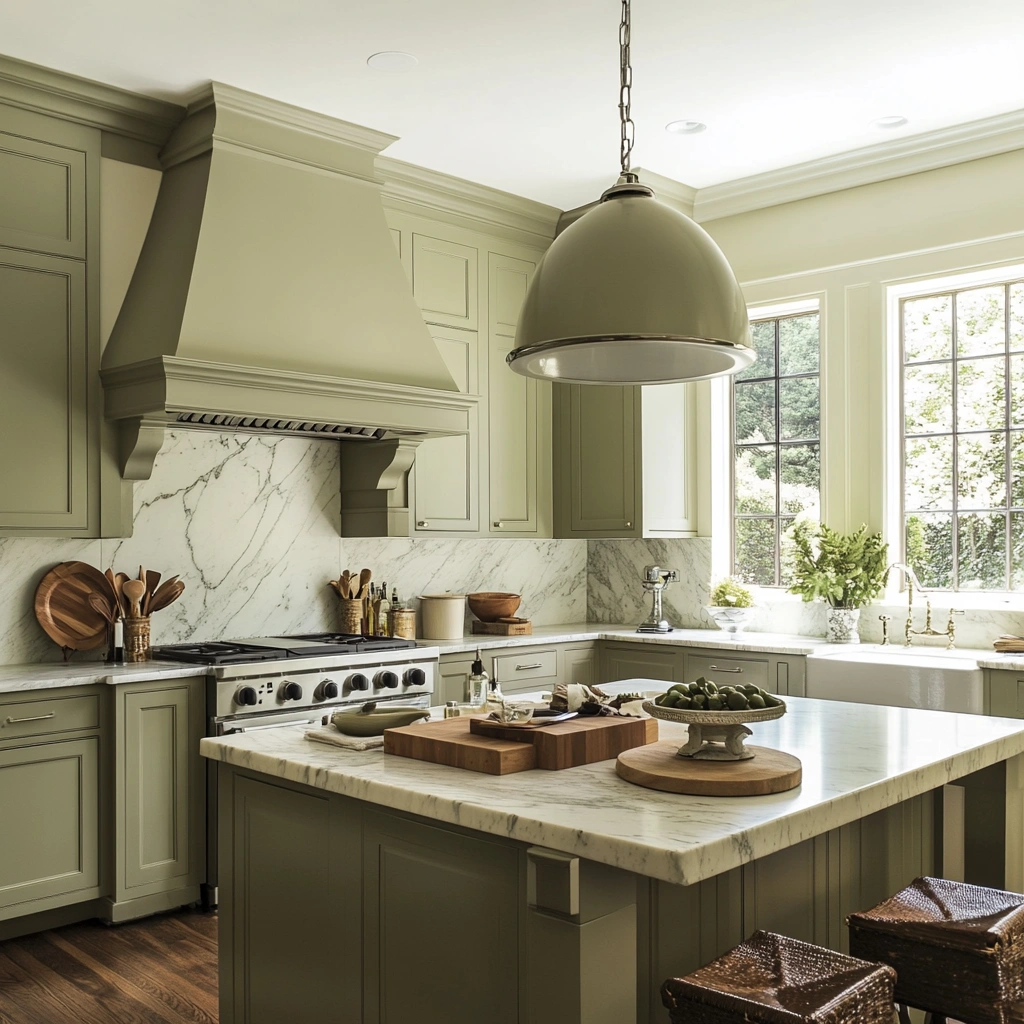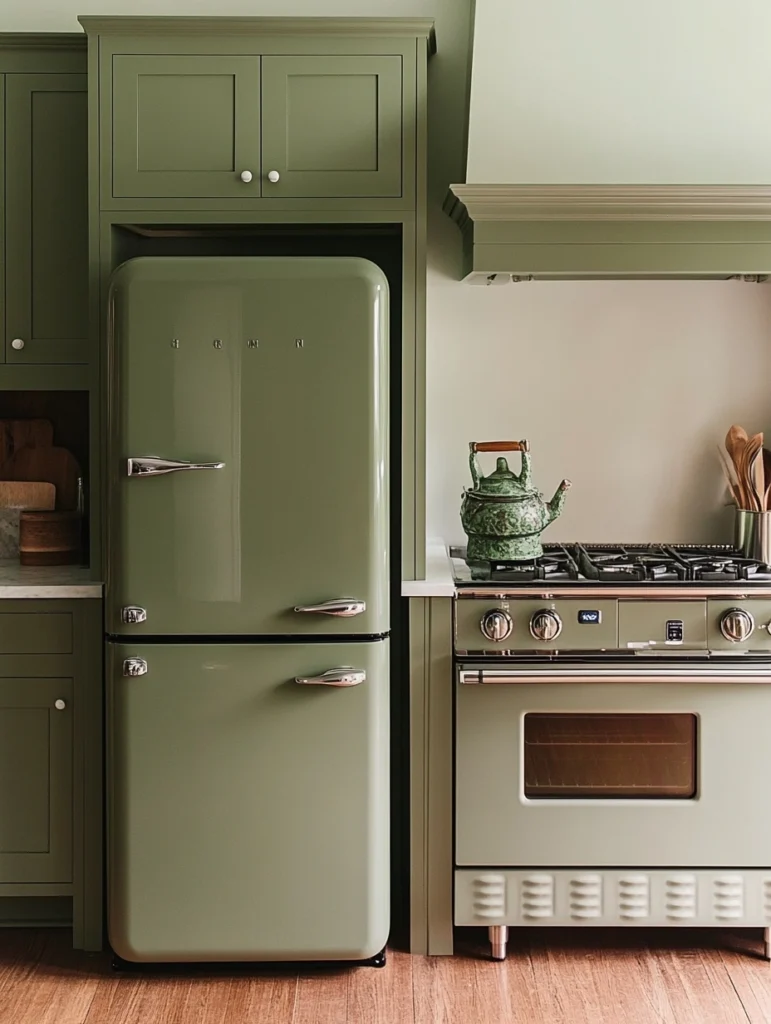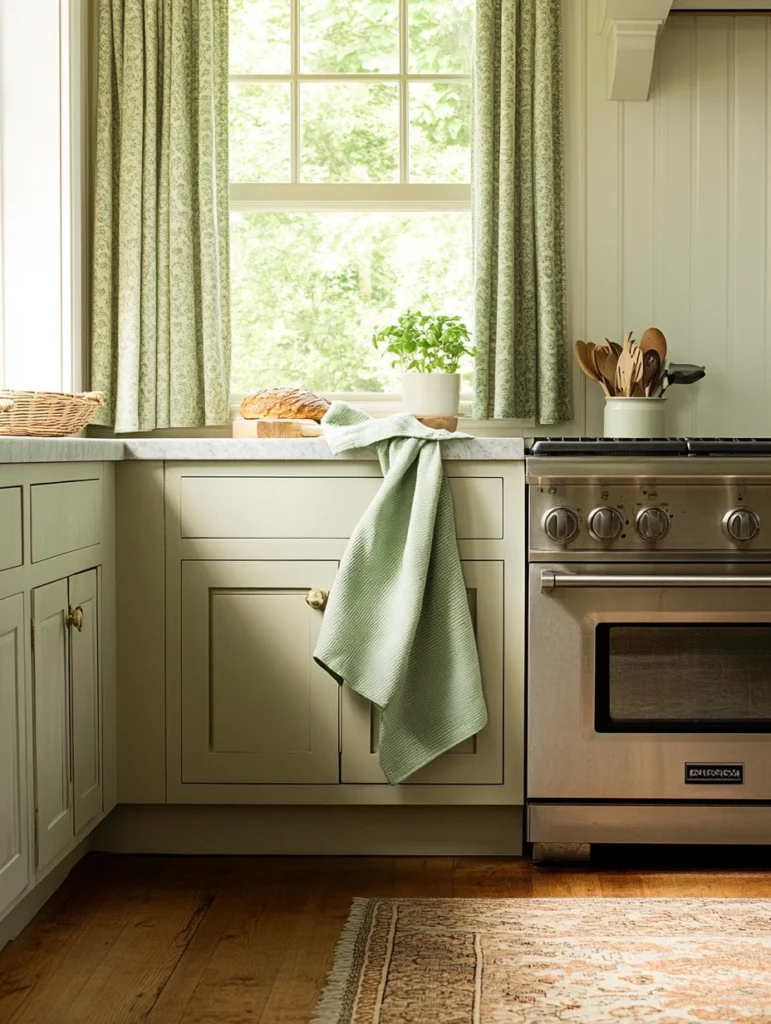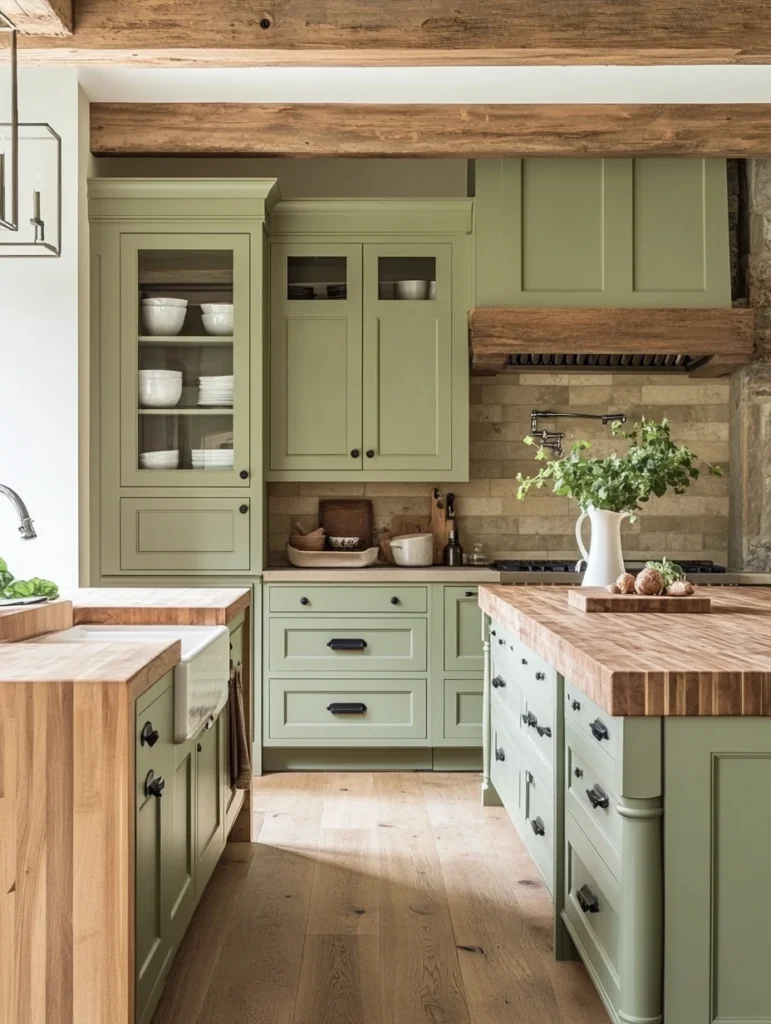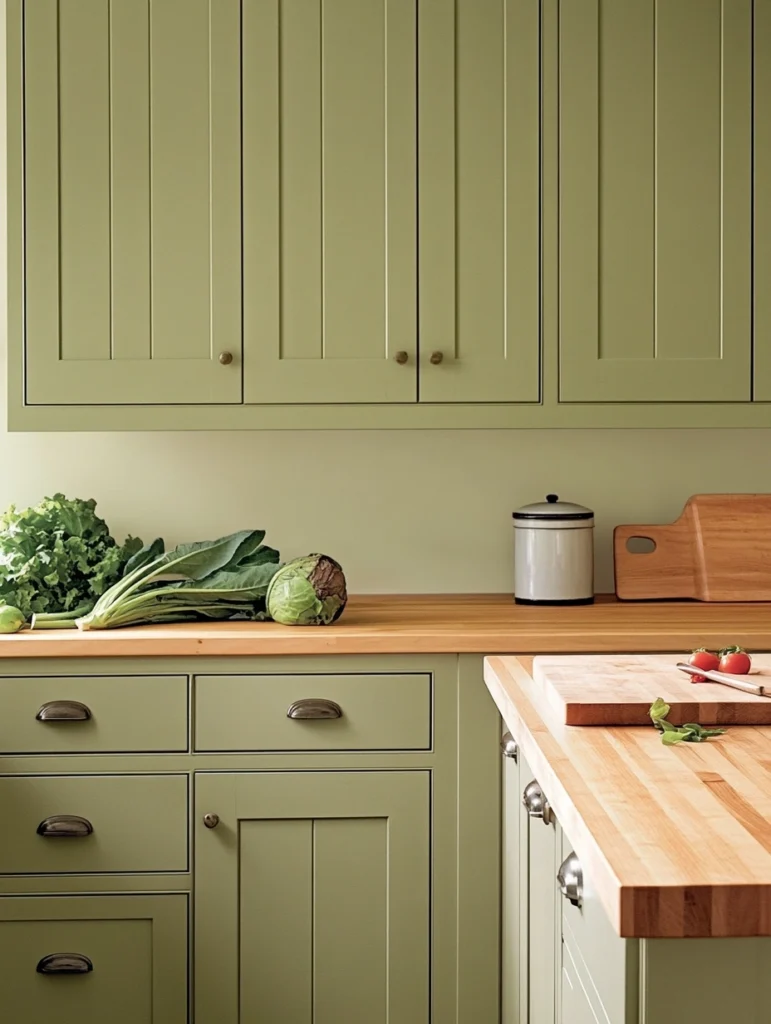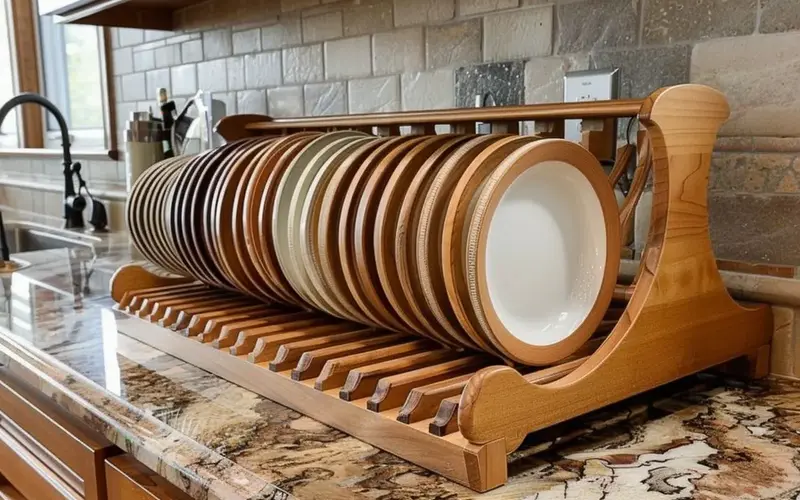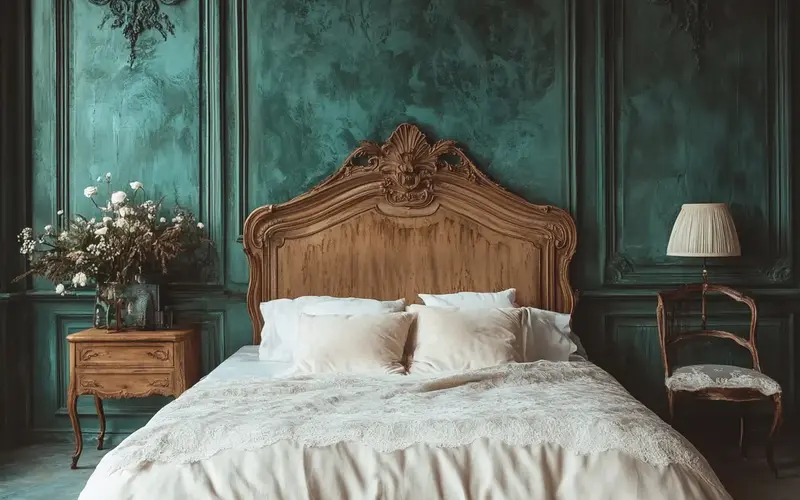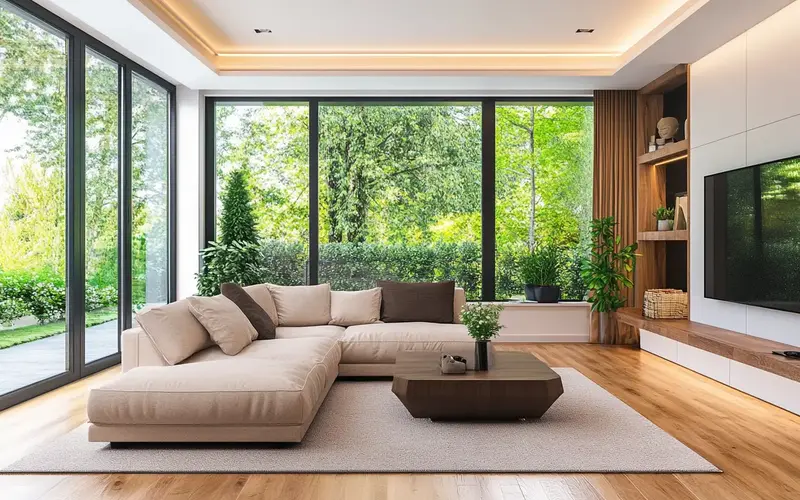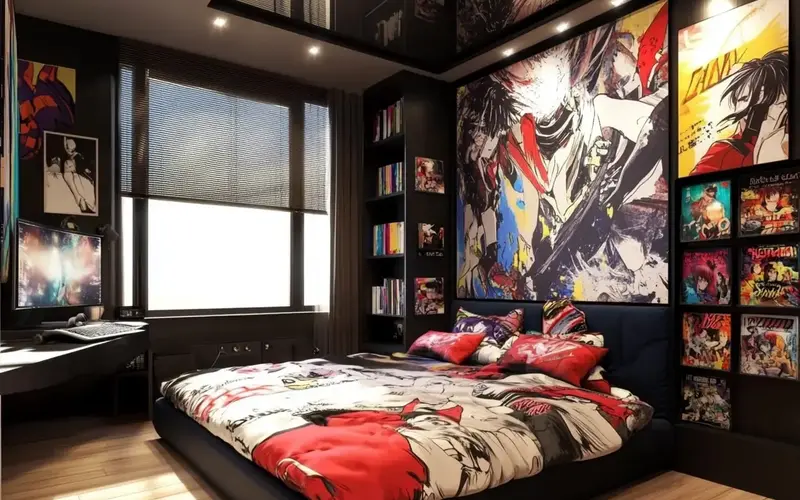Okay, so picture this: you’re scrolling through Pinterest, dreaming of a kitchen refresh, and you keep seeing this one color pop up everywhere. It’s calming, it’s chic, and it feels like a breath of fresh air. Yep, I’m talking about sage green! This isn’t your grandma’s avocado green; this is a sophisticated, versatile hue that can totally transform your kitchen into a serene and stylish haven.
If you’re ready to ditch the all-white kitchen or just want to inject some beautiful, earthy color into your space, grab your favorite mug and let’s chat about 21 ways to make sage green shine in your kitchen. Trust me, there’s an idea in here for everyone, no matter your style or budget!
Sage Green Kitchen Cabinets
The Inspiration: You’ve seen those stunning kitchens on Instagram, the ones where the cabinets are a gorgeous color that just feels right. You’re tired of plain old white or wood and want something with personality, but nothing too loud or trendy that you’ll hate in a year. You’re craving a kitchen that feels grounded, natural, and effortlessly stylish.
Why it works: Painting your kitchen cabinets sage green is a game-changer. It provides a significant visual impact and sets the tone for the entire room. Unlike bright colors that can feel overwhelming, sage green is naturally soothing. It acts as a beautiful, soft backdrop that pairs wonderfully with tons of different countertop, backsplash, and hardware choices. It hides minor scuffs and fingerprints better than super light or dark colors, which is a huge win in a busy kitchen.
Pro Tip: Before committing to all your cabinets, grab a few sample pots of different sage green shades and paint large swatches on your existing cabinet doors. Look at them in different lights throughout the day – natural morning light, harsh midday sun, and under your kitchen lighting at night. The color can look different depending on the light! This step is crucial for finding your perfect sage.
Read More: 21 Inexpensive Covered Outdoor Kitchen Ideas
Two-Tone Cabinetry with Sage Green Lowers
The Inspiration: You love the idea of sage green cabinets, but maybe painting all of them feels a little too much, or you have a smaller kitchen and worry it might feel heavy. You want to incorporate the color you love, but need a way to keep the space feeling bright and open, especially up high.
Why it works: Going for two-tone cabinetry is a brilliant compromise! Painting just your lower cabinets in a beautiful sage green while keeping your upper cabinets a crisp white, cream, or even a light natural wood creates fantastic visual interest. This anchors the kitchen with the calming sage on the bottom while the lighter uppers keep the eye drawn upward, making the space more expansive and airy.
Pro Tip: Consider the transition point between the two colors. If you have a kitchen island, you could paint the island in sage green to tie into the lower cabinets, or keep it the color of the upper cabinets for contrast. Also, think about your countertops – a light counter will bridge the gap between the two cabinet colors beautifully.
Read More: 17 Beautiful White Oak Cabinet Kitchen Ideas
Sage Green Kitchen Island
The Inspiration: Your kitchen is already pretty great, but maybe it feels a little… plain? You’ve got standard cabinets, but you want to inject some personality and create a defined hub in the room. You’ve seen colorful islands and love the idea, but you want a color that feels timeless and integrates well with your existing finishes.
Why it works: Painting your kitchen island in sage green is an excellent way to introduce this lovely color without committing to painting all your main cabinets. The island naturally serves as a focal point in most kitchens, and giving it a pop of sage green elevates it into a stylish statement piece. It provides a beautiful anchor in the room and is a perfect spot to bring in that touch of nature-inspired calm.
Pro Tip: Coordinate the hardware on your sage green island with the hardware on your main cabinets for a cohesive look, or choose a slightly different finish (like brass on the island and black on the cabinets) to make the island stand out even more as a feature.
Read More: 17 Ideas for Kitchen Cabinet Handles
Sage Green Walls Paired with White Cabinets
The Inspiration: You love the idea of a sage green kitchen, but maybe painting the cabinets feels like too big a project or investment right now. Your current cabinets are perfectly fine (maybe they’re white or a light neutral), but the walls are looking a little tired and boring. You want to add color and character without a major renovation.
Why it works: Painting your kitchen walls in a beautiful shade of sage green while keeping your cabinets white or a light neutral is a fantastic way to get that sage green vibe with less commitment than painting cabinetry. It immediately adds warmth, color, and personality to the space. The white cabinets pop beautifully against the soft green backdrop, creating a fresh and airy feel that’s incredibly inviting.
Pro Tip: Make sure your wall paint is a durable, scrubbable finish designed for kitchens. Kitchens can get messy, and you’ll want to be able to easily wipe down any splashes or splatters without damaging the paint. Look for paints specifically labeled for kitchen and bathroom use.
Read More: 17 Kitchen Countertop Decor Ideas I’m Obsessed With
Sage Green Backsplash Tiles
The Inspiration: Your kitchen is functional, but it lacks that certain something. The walls are painted, the cabinets are fine, but the space behind your counters and stove feels like a blank canvas. You want to add texture, pattern, and color in a place that’s both practical and beautiful.
Why it works: A sage green backsplash is a stunning way to introduce this color and add visual interest right in the heart of your workspace. It’s a defined area, so even a bold tile choice won’t overwhelm the room. You can choose from a huge variety of sage green tiles – classic subway tiles for a timeless look, geometric patterns for something modern, or even textured zellige tiles for an earthy, handcrafted feel.
Pro Tip: Don’t be afraid to play with grout color! A white or light gray grout will make sage green tiles pop and look crisp, while a darker gray or even a coordinating green grout can create a more seamless or dramatic look. Get a few sample tiles and try different grout colors before you decide.
Read More: 17 Brilliant Open Shelving Pantry Kitchen Ideas
Open Shelving with Sage Green Accent Wall
The Inspiration: You like the open and airy feel of open shelving, and you’re looking for a way to make those shelves stand out. You want to add color and personality to your kitchen walls, but maybe you don’t need to paint the entire room.
Why it works: Combining open shelving with a sage green accent wall behind it is a match made in design heaven! The open shelves prevent the wall color from feeling too dominant, while the sage green wall makes whatever you display on the shelves – pretty dishes, cookbooks, plants – really pop. It creates a lovely focal point and adds depth and visual interest to that specific area of your kitchen.
Pro Tip: Curate what you put on your open shelves! Since they’re exposed, they can easily look cluttered. Stick to items you use frequently or genuinely love to look at. Mix in some small plants or decorative objects to break up the stacks of dishes and add to the natural vibe of the sage green.
Read More: 17 Ideas for Black Kitchen Sinks To Transform Your Kitchen
Sage Green Appliances
The Inspiration: You’re ready to make a serious statement in your kitchen! You love color and aren’t afraid to go beyond the usual stainless steel, black, or white appliances. You want your kitchen to feel unique and have a touch of vintage charm or unexpected personality.
Why it works: Opting for major or minor appliances in a sage green finish is a bold and fun choice that immediately gives your kitchen a distinctive look. Imagine a beautiful retro-style refrigerator or a sleek modern range in sage green – it becomes a design feature in itself! This works especially well if you want to keep your cabinetry neutral and let the appliances be the stars.
Pro Tip: If investing in major sage green appliances isn’t in the cards, start smaller! Look for stand mixers, toasters, kettles, or even a microwave in a sage green finish. These smaller appliances can add those fun pops of color to your countertops and provide a similar, though smaller-scale, effect.
Read More: 21 Kitchen Remodel Ideas: Transform Your Cooking Space
Incorporating Sage Green Through Textiles
The Inspiration: You love the sage green trend, but you’re not ready for paint or major changes. You want to add color and softness to your kitchen in a way that’s easy to update and doesn’t require any DIY skills beyond maybe hanging a curtain rod.
Why it works: Using sage green in your kitchen textiles is the perfect low-commitment way to embrace this beautiful color! Think pretty sage green dish towels draped over the oven handle, a soft rug underfoot, charming window curtains, or even seat cushions on kitchen chairs. Textiles add warmth, texture, and color instantly. They soften the harder surfaces of a kitchen and make the space feel more inviting and lived-in.
Pro Tip: Mix and match different textures and patterns within your sage green textiles. A solid sage green linen dish towel paired with a patterned rug that incorporates sage green can add visual depth and make the design feel more layered and interesting.
Read More: 21 Brilliant Lighting Ideas for Your Small Kitchen Island
Sage Green Seating
The Inspiration: You have an island or a kitchen table that feels a little disconnected from the rest of your kitchen’s style. You want to make this seating area feel more like a part of the overall design and inject some color and personality there.
Why it works: Adding stools or chairs in a sage green finish or with sage green upholstery is a fantastic way to bring this calming color directly into your kitchen’s dining or gathering spot. It helps to visually connect the seating area with other sage green elements in the room, creating a cohesive look. It’s a less conventional place to add color, making it a stylish and unexpected design choice.
Pro Tip: Consider the material of the seating. Wood stools painted sage green offer a more rustic or traditional feel, while metal stools or upholstered chairs in a performance fabric (key for the kitchen!) in sage green can lean more modern or transitional. Choose a material that complements your overall kitchen style.
Read More: 15 Stylish Wooden Dish Drying Rack for the Kitchen
Mixing Sage Green with Natural Wood Tones
The Inspiration: You love the warmth and character that natural wood brings to a space. You want to incorporate color into your kitchen, but you don’t want to lose that cozy, earthy feeling that wood provides. You’re looking for a color that feels like it belongs alongside wood, enhancing its natural beauty.
Why it works: Sage green and natural wood are a match made in heaven because they are both colors found in nature! The earthy, muted tone of sage green complements the warmth and variations in wood grain beautifully. This pairing creates a kitchen that feels incredibly grounded, serene, and organic.
Whether you have wood cabinets, wood flooring, a butcher block countertop, or just wood shelves and cutting boards, introducing sage green through paint or accessories will enhance the natural beauty of the wood and create a cohesive, calming environment.
Pro Tip: Pay attention to the undertones of your wood and your sage green. Warmer woods (like oak or cherry) often pair well with sage greens that have slightly warmer or more yellow undertones, while cooler woods (like ash or some maples) can look great with cooler or gray-leaning sage greens.
Read More: How to Create a Serene Kitchen with Sage Green Cabinets?
Sage Green with Brass or Gold Hardware
The Inspiration: You’ve decided on sage green cabinets or a sage green island, and now it’s time for the finishing touches. You want hardware that feels elevated and adds a touch of luxury and warmth to the space. You see all the beautiful brass and gold fixtures everywhere and wonder if they’d work with your green vision.
Why it works: Oh, they work! Pairing sage green with brass or gold hardware is a truly stunning combination that adds a touch of sophistication and warmth. The rich, metallic tones of brass and gold provide a beautiful contrast to the muted, earthy sage green, making the cabinets or island feel instantly more refined and luxurious. It’s like adding jewelry to an outfit!
Pro Tip: Carry the brass or gold finish beyond just the cabinet hardware. Consider matching your kitchen faucet, pendant lights over the island, or even small decorative items like trays or picture frames in the same metallic tone to create a truly cohesive and polished look.
Read More: 17 Ultra Chic Rustic Kitchen Ideas You Can Try Right Now
Matte Black Accents in a Sage Green Kitchen
The Inspiration: You love the calming nature of sage green, but you also gravitate towards more modern or slightly industrial design elements. You want to add some contrast and definition to your kitchen without using shiny metallics or bright colors.
Why it works: Introducing matte black accents into a sage green kitchen creates a chic and sophisticated contrast that feels very current. Matte black hardware, faucets, lighting fixtures, or even appliance handles provide a subtle graphic element that helps to define lines and add a touch of modern edge against the softer sage green.
Unlike polished black, the matte finish absorbs light, giving it a softer, more contemporary feel that pairs beautifully with the muted green.
Pro Tip: Don’t overdo it with the black. A few carefully placed matte black elements are usually enough to make an impact without making the kitchen feel too dark or heavy. Think cabinet pulls, a faucet, and maybe pendant lights – just enough to provide that modern contrast.
Read More: 21 Beautiful Kitchen Islands That’ll Upgrade Your Look
Sage Green Paired with Butcher Block Countertops
The Inspiration: You’re dreaming of a kitchen that feels warm, inviting, and perhaps a little bit country or farmhouse-inspired. You love the natural look and feel of wood and want your countertops to contribute to that cozy vibe. You’re looking for a countertop material that beautifully complements the natural feel of sage green.
Why it works: Sage green and butcher block countertops are a classic pairing for a reason – they just look fantastic together! The warm tones and natural grain of the butcher block provide a beautiful, earthy contrast to the cool, calming sage green. This combination immediately creates a kitchen that feels welcoming, grounded, and full of natural charm. It’s perfect for farmhouse, cottage, or even transitional styles.
Pro Tip: Remember that butcher block requires regular maintenance, including oiling, to keep it looking its best and protect it from water damage. Be prepared for this upkeep, or consider using butcher block only on an island or a less-used section of countertop if you prefer lower maintenance.
Read More: 17 Easy Kitchen Storage Ideas That Will Change Your Life
Sage Green and White Marble Countertops
The Inspiration: You love kitchens that feel bright, elegant, and timeless. You’re drawn to the classic beauty of marble countertops and are looking for a cabinet color that will enhance their luxurious feel without being too stark or traditional.
Why it works: Pairing sage green cabinets with white marble countertops (or a good quality marble-look quartz) creates a kitchen that feels incredibly elegant and sophisticated. The cool tones and beautiful natural veining of the marble provide a stunning contrast to the soft, earthy sage green. This combination is both fresh and classic, offering a timeless appeal that won’t quickly go out of style.
Pro Tip: While natural marble is gorgeous, it requires sealing and is prone to etching and staining. If you love the look but want something more durable and low-maintenance, explore the many excellent quartz options available that mimic the look of white marble.
Read More: 17 Kitchen Organization Ideas That Just Make Sense
Sage Green in a Farmhouse Style Kitchen
The Inspiration: You adore the cozy, comfortable, and charming aesthetic of farmhouse style. You want your kitchen to feel warm, inviting, and full of character, and you’re looking for a color that perfectly complements those rustic elements like shiplap, wood beams, and apron sinks.
Why it works: Sage green is a natural fit for farmhouse style because it’s an earthy, calming color that evokes the feeling of the countryside. It pairs beautifully with the common elements of farmhouse design – the warmth of natural wood, the crispness of white shiplap, the simplicity of an apron sink, and the classic lines of shaker cabinets.
Using sage green on cabinets or walls in a farmhouse kitchen enhances that feeling of being connected to nature and creates a relaxed, welcoming atmosphere that’s perfect for gathering with family and friends.
Pro Tip: To lean into the farmhouse vibe, consider using a slightly distressed or aged finish on your sage green cabinets, or pair them with vintage-inspired hardware like cup pulls or simple knobs in black or antique brass.
Read More: 21 Stunning Modern Luxury Kitchen Ideas
Modern Minimalist Sage Green Kitchen
The Inspiration: You love clean lines, uncluttered spaces, and a sense of calm order. Your ideal kitchen is streamlined and functional, but you don’t want it to feel cold or sterile. You’re looking for a color that adds warmth and personality while still fitting within a minimalist aesthetic.
Why it works: Sage green can be surprisingly effective in a modern minimalist kitchen! When used on sleek, handleless cabinets with simple profiles, sage green adds a touch of color and softness that prevents the space from feeling too stark. Its muted tone is calming and sophisticated, aligning perfectly with the minimalist desire for tranquility and simplicity.
Pro Tip: In a minimalist sage green kitchen, focus on quality over quantity for your accessories. A single beautiful piece of pottery, a minimalist vase with a few green sprigs, or a sleek, sculptural fruit bowl is all you need to add personality without creating clutter.
Read More: 21 Kitchens With Light Wood Cabinets
Adding Sage Green Through Decorative Accessories
The Inspiration: You’re on a tight budget, or you rent your home and can’t make permanent changes. You love sage green and want to incorporate it into your kitchen to refresh the look and feel of the space without painting or renovating.
Why it works: The easiest and most budget-friendly way to introduce sage green is through decorative accessories! This is where you can have fun and experiment without any long-term commitment. Think about swapping out your current kitchen decor for items in sage green – a new set of canisters, a utensil holder, a soap dispenser, a pretty pitcher, or even framed botanical prints that feature the color.
Pro Tip: Group your sage green accessories together in a few spots rather than scattering them evenly throughout the kitchen. A collection of different-sized sage green plant pots on a windowsill or a cluster of sage green ceramics on a shelf can create a more impactful and intentional display.
Sage Green Lower Cabinets with Open Upper Shelving
The Inspiration: You’re drawn to the practicality and modern look of open shelving, especially in the upper part of the kitchen, to display frequently used items or decorative pieces. You also want to incorporate a lovely color like sage green on your base cabinets, but you’re concerned that colored upper cabinets might feel too heavy or enclosed.
Why it works: Combining sage green lower cabinets with open shelving above is a fantastic design strategy that offers the best of both worlds. The sage green on the base cabinets grounds the kitchen and provides that beautiful pop of color and connection to nature where it’s most visible and impactful.
Meanwhile, the open shelving on top keeps the upper portion of the kitchen feeling light, airy, and spacious. This visually expands the room and provides an opportunity to curate beautiful displays.
Pro Tip: Ensure the items you plan to display on your open shelves are neat and visually appealing since they will be constantly on view. Stick to organized stacks of plates, tidy rows of glasses, or decorative items that complement your sage green and overall kitchen style. Avoid clutter!
A Pop of Sage Green on the Interior of Glass-Front Cabinets
The Inspiration: You have glass-front cabinets and want to make them a little more interesting. You love the idea of adding color to your kitchen, but you want something subtle and unexpected, a little hidden gem that adds charm without being immediately obvious.
Why it works: Painting the inside back panel of your glass-front cabinets in sage green is a delightful and subtle way to introduce this calming color into your kitchen. It adds a lovely pop of color that is visible through the glass, highlighting the dishes, glassware, or decorative items you store inside. It’s a less common design choice, making it feel special and intentional.
Pro Tip: If you have a lot of colorful dishes or glassware, choose a slightly more muted or gray-leaning sage green for the interior of the cabinets so that the color of your displayed items can still shine. If your dishes are mostly white or neutral, you can go for a slightly richer sage green to make them pop.
Utilizing Sage Green in a Galley Kitchen
The Inspiration: You have a galley kitchen, and while it’s functional, it sometimes feels a little long, narrow, or lacking in personality. You want to use color to make the space feel more inviting, maybe a little wider, and more stylish, but you’re worried that color might make it feel even smaller.
Why it works: Sage green is a fantastic color choice for a galley kitchen precisely because of its calming and earthy qualities. Unlike bright or dark colors that can sometimes make a narrow space feel more closed in, sage green feels expansive and brings a sense of the outdoors in. Using it on cabinets or walls can help to visually connect the two sides of the galley and create a cohesive, serene tunnel effect rather than a cramped one.
Pro Tip: In a galley kitchen, consider painting the end wall (the one without cabinets or major appliances) in sage green to create a focal point and draw the eye down the length of the room, making it feel less like a corridor and more like a destination.
Combining Different Shades of Green with Sage
The Inspiration: You love green and want your kitchen to feel like a lush, verdant retreat. You’re not afraid to embrace color and want to create a kitchen design that has depth, visual interest, and a rich connection to the natural world by using more than just one shade of green.
Why it works: Layering different shades of green within your kitchen, with sage green as a key player, creates a sophisticated and immersive design. You can use a deeper forest green on lower cabinets, a soft sage on the uppers, and a lighter mint green on an accent wall or backsplash. This creates a dynamic palette that feels incredibly natural and organic, just like the variations in foliage in a garden.
Pro Tip: When combining multiple shades of green, make sure they have similar undertones (either all leaning warm or all leaning cool) to ensure they harmonize well together. Use natural materials like wood, stone, and plants to further enhance the earthy, layered green palette.
Final Thoughts
See? Sage green is seriously magical in the kitchen! Whether you’re ready to dive in with painted cabinets or just want to sprinkle in some color with accessories, there’s a way to make this beautiful hue work for you. It’s calming, it’s stylish, and it brings such a lovely, natural vibe into the heart of your home. Which idea are you itching to try first? Don’t be shy – pick the one that speaks to you and start planning your little piece of sage green heaven! Happy decorating!
